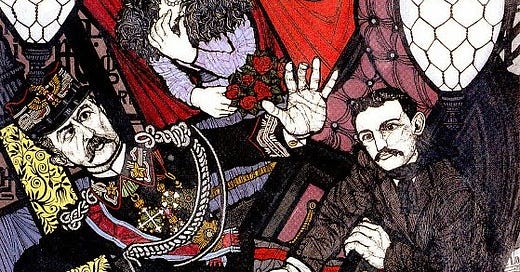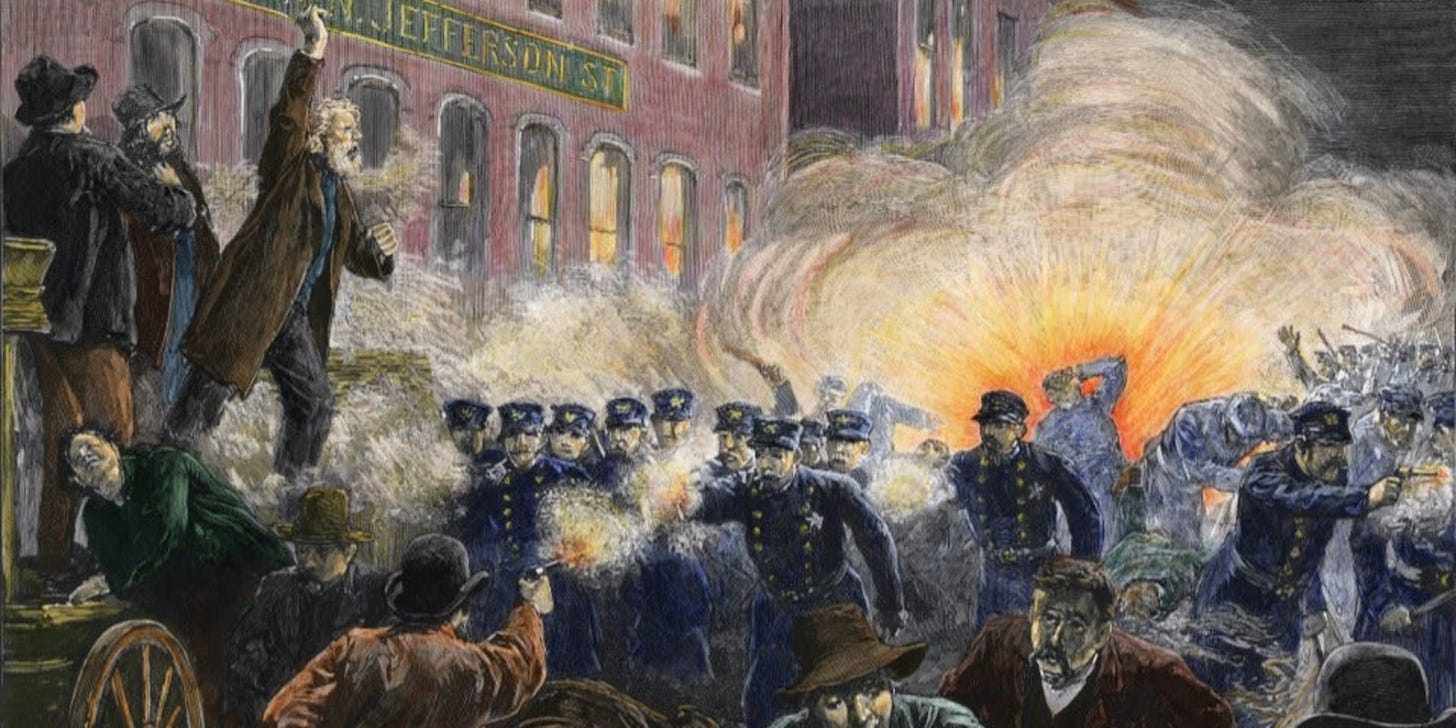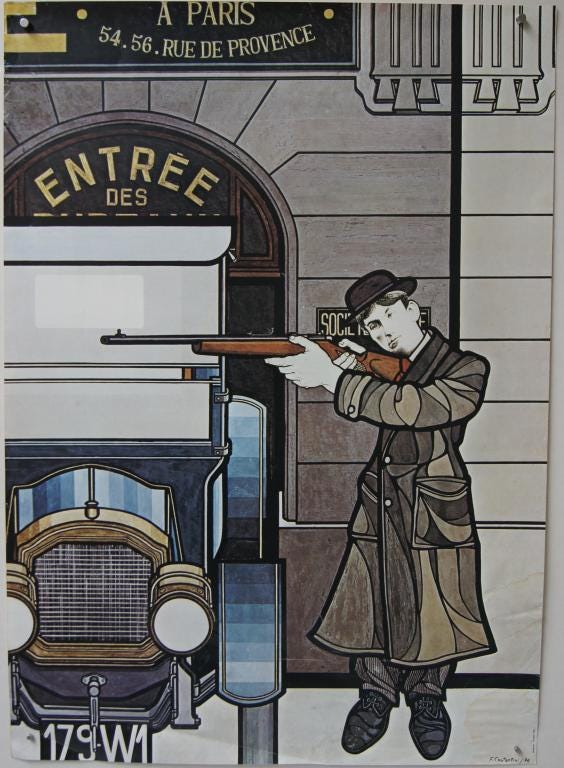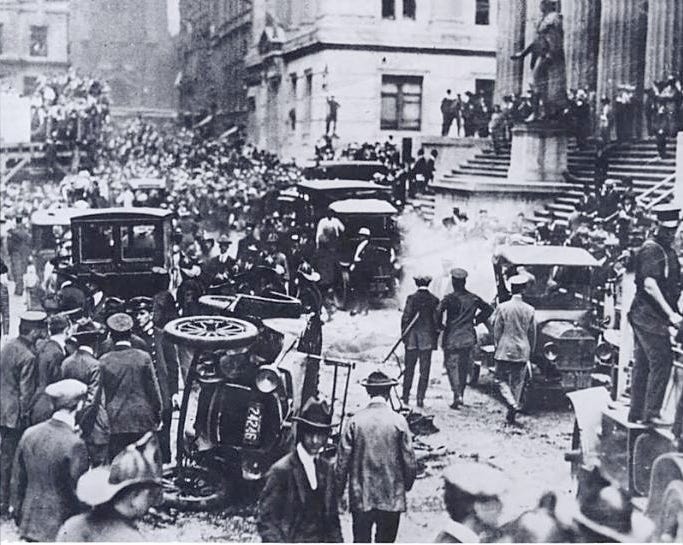Do you know how many young people supported Luigi Mangione’s hit on that UnitedHealthcare CEO? According to polling, at least half, which is far more than the number of young people who opposed it.
Though Luigi wasn’t an anarchist, his action was a clear example of a type of action that has long been in the anarchist toolbox: propaganda by the deed. (Propaganda, in most languages, just means ways of spreading information or ideas, and it had this meaning in English too until around the Red Scares and the Cold War.)
Propaganda by the deed just means showing people what your beliefs and proposals are through action instead of posters or pamphlets or giving speeches. (Anarchists like all anticapitalists do all of those things, but only the first one qualifies as propaganda by the deed.) We show we are opposed to capitalism by burning down banks. We show we are opposed to authority by assassinating kings and presidents. We show we are capable of defending ourselves from repression by blowing up police stations.
At a time when healthcare is treated like a business and insurance companies are making billions while people suffer and die from treatable illnesses with no access to medicine, killing one of those parasitical multimillionaires shows that, well, we refuse to quietly die invisible, polite deaths.
May Day!
May Day is a great day to remember that propaganda by the deed is an integral part of our movement. After all, in 1886 a multiracial and multi-ethnic coalition of anarchist and socialist workers organized a general strike across the US for an eight hour limit to the workday – for the anarchists, this was a way to reduce the misery of the working class and improve our prospects for survival, as just one step on the road to abolishing wage labor and capitalism as a whole.
Probably millions put down their tools and refused to work, and certainly hundreds of thousands marched in major cities around the country. In Chicago, the city with the highest participation in the strike, many of the German immigrant workers had been reading the radical newspaper published by the anarchist Albert Spies, and the largest march was led by anarchists Lucy and Albert Parsons.
When police cracked down hard, beating and arresting numerous strikers and killing between two and six workers when they opened fire on a picket line in Chicago, the anarchists organized a rally for May 4 in Haymarket Square. This time, when the police charged and prepared to open fire on the crowd, someone threw a bomb, killing several cops.
The fact is, there were anarchist bomb-throwers, and they were also workers and organizers who were an integral part of the strike. The specific tactic of using guns or explosives was a way to create consequences for the police, the government, and the wealthy, when the repressive apparatus was killing people left and right with total impunity.
Albert Parsons and August Spies, two of the people executed in the aftermath, almost certainly had nothing to do with the bombing, but the same can’t be said of, for example, Louis Lingg, another of the seven anarchists sentenced to death for the Haymarket Riot. His alibi in court, actually, was that he wasn’t present at the Haymarket rally – he was at home, busy building more bombs.
Infiltrators and Infiltrators
The two common fictions we hear to denounce or delegitimize propaganda by the deed and similar acts of struggle are:
They’re actually the work of provocateurs and infiltrators
They scare people away
Exclusive nonviolence in social movements has already been thoroughly debunked as an ineffective methodology perpetuated with authoritarian means and resting the distortion and erasure of our histories of struggle.
But let’s look at these specific arguments against propaganda by the deed.
1. What actual infiltrators aim for is the pacification of the struggle. Plenty of infiltrators, along with big NGOs, academics, media, and others who use their access to resources to condition the movement, are direct: they simply insist on more and more strenuous codes of nonviolence for any movement demonstrations, while doing nothing to disarm the police and the far Right.
Others will spread rumors, which is called badjacketing. Cops and informants in prison and in the movement often use one specific form of this tactic to get revolutionaries and subversives killed: snitchjacketing is when someone claims to know, or spreads speculation, that someone else is a snitch, a cop, or an agent provocateur. To be clear, it’s not always cops or informants who are responsible for badjacketing. Plenty of legit pacifists and middle class conspiracy theorists do this work for the police for free. During 2020, predominantly white sleuths on the internet got at least three people locked up—two of them were Black, the other was the partner of a Black man the pigs had just murdered—by spreading the assertion that they were outside agitators and encouraging people to help identify them.
Historically, it is true that sometimes the cops have orchestrated bombings or other illegal acts. Vanguardists who dream they’re the heroic leaders of the revolution will always say the purpose is to “delegitimize the movement” but it’s actually much more complicated than that. (And, as history has tried to tell us time and again, vanguardists will do their best to expel, denounce, badjacket, rat out, or ultimately kill anyone who isn’t following their orders.)
Generally, there are two ways it can go: when cops really need to make some arrests because of the political situation, they will orchestrate an illegal action with a combination of agents, informants, and unsuspecting, sincere radicals. The whole operation will be under surveillance, and either right before or right after the action occurs (or as in the case of Eric McDavid, when the targets are about the leave the group, sick of the coercion and bullying of the person who’s working for the pigs), they close the trap and make their arrests. This helps them produce a climate of repression that will make other people afraid to break the law or participate in the struggle. It makes it seem like the police are omniscient and invincible, when in reality, it is usually pretty easy to break the law and get away with it, even to carry out tremendously daring attacks, as long as you follow some basic steps and do your homework.
2. In the second case, sometimes cops or secret services will carry out false flag operations. The US and British militaries did this in Iraq to disempower the secular resistance and help al-Qaida -linked groups take over the resistance to the occupation. A little more pertinent to our discussion: between 1890 and 1910, when Barcelona was the atentado capital of the world, a few of the hundreds of bombings and assassinations or attempts that were carried out were actually the work of police infiltrators or informants. There’s a key characteristic of the police-orchestrated bombings: they went off in the middle of protest marches, in marketplaces in working class neighborhoods, or otherwise had questionable targets and messy results. The atentados—the attacks—carried out by actual anarchists overwhelmingly struck cops, key capitalists and industrialists, or high-ranking government officials and heads of state, usually as a direct response to a brutal act of repression.1
It’s simply inaccurate to say that such actions “scared people away” or “gave the movement a bad name,” because in fact they were immensely popular among broad swathes of the working class, showing that justice could actually be achieved in this lifetime, that the wretched of the earth had the power to strike back.
Once we are able to admit this, we can see the second purpose of police-orchestrated attacks: to blur the lines between principled attacks against murderous rulers, and sloppy, ends-justify-the-means attacks that often included members of the lower classes amongst the victims. If the line between uncompromising struggle and wrathful, mindless cruelty could be blurred, it would make it easier for the media and the State to denounce all forms of revolutionary attack with one broad brush.
So in a way, the real infiltrator here is the frightened idea that propaganda by the deed is something bad, something exceptional, something we need to denounce. This is an idea that overwhelmingly comes from people who are comfortable, from academics who write about struggle, from professional activists with middle class sensibilities.
Oftentimes, they’re well intentioned and just regurgitating moralistic frameworks from the internet, or they’re academics who aren’t fluent in Spanish, Italian, and Catalan, where we can find most of the historical material that disputes this pacified interpretation of revolutionary history. Other times, they’re using simplistic tools of historical and strategic analysis.
For example: well, if we take the almost mythical anarchist movement of the Iberian peninsula (Spain, Catalunya, Euskadi, etc.), we can see that propaganda by the deed was most common, or made up the largest proportion of movement activity, between 1890 and 1910, when the organized workers’ movement was weakest. Then the CNT was formed and grew and grew and then there was the social revolution in 1936! [If they also want to denounce insurrectionary methods, they’ll point out the crushed insurrections of 1932, 1933, 1934.] Clearly, propaganda by the deed correlates with a weaker movement, and therefore causes a weaker movement, whereas a formal anarchist workers’ federation correlates with a stronger movement and a revolution, and therefore is the cause of a stronger movement and revolution!
Like I said, we will look at what is grossly simplistic and tragically wrong about that analysis in a forthcoming essay. But first!
How about those polls?
I mentioned there were actual scientific polls showing young people largely supported Luigi’s deed. This in itself is a huge deal. The fact that any mainstream media dared ask this question of subversive desire—remember that in a democracy, those in power stay in power not by prohibiting certain answers but by controlling what sorts of questions are asked in the first place—is already an indication that the killing of a health insurance profiteer and the public outpouring of excitement and support terrifies them. They needed to get scientific and find out just how much support such actions have, especially among the younger generations.
(Also keep in mind how the poll results were skewed, a typical example of how pollsters and data analysts can often get the answers they want or at the very least prevent more unsettling results from emerging. One of the polls I found skewed upper class, only polling university students—and just imagine what young poor people think about health insurance companies—and the other polled “voters.” Some people vote because they just don’t care, a lot of people don’t vote because they have absolutely no faith in the system. Ultimately, there is probably a solid majority of young people who supported that action.)
And that’s one of the things I found most valuable about Luigi’s action: it cut through the bullshit. At a time of liberals and progressives clutching their pearls and inducing everyone—even some anarchists, I’m ashamed to admit—to panic not over the suffering caused by the Trump administration but over the dismantling of democratic institutions, the targeted killing of someone who makes millions off of denying people healthcare, off of profiting off the death and illness of people like you and me, showed people’s real allegiances. In the rightwing media and the center-left media, they condemned his terrorism. People in progressive movement spaces either stayed silent or they tsk-tsked and moralized about how it was another sign we needed healthcare reform (again). But in the streets, in the actual streets, droves of people celebrated, laughed, and cheered! We felt joy that for one day at least, the shoe was on the other foot.
In other words, independent of their political identities, some people sided with the system, and some people sided with life. Those are exactly the points of rupture that anarchists, that any serious and sincere revolutionaries, need to inhabit.
Similar things happened in 2020, when a majority of people decided they were in support of this huge uprising toppling statues, taking over highways and city blocks, and burning down police stations. The only people denouncing those kinds of actions were on the side of the police.
When we condemn the category of our methods that most elicit the moral horror of the bourgeoisie,2 propaganda by the deed, we lose our ability to be present to what is actually inspiring to people who are ground down by this system.
In conclusion, it’s an incredibly thoughtless moment for wholesale denunciations of propaganda by the deed, especially when that involves erasing or falsifying our historical experience with that method.
In the most extreme cases, in a climate of intense repression an anarchist attack would target the owning class more broadly, for example a cultural gathering of a city’s wealthiest citizens. These attacks were controversial, receiving more criticism from within the movement, but it would not be honest to say they were completely foreign or external to the struggle.
No, it’s not terrorism that is most shocking to the dominant morality: look how quickly the mainstream will fall in line with war strategies of “Shock and Awe” or the obvious terrorism of the Israeli state and Israeli settlers.









There is a young bloke listing all the vacant properties in the colony's cities and directing the homeless how to squat them, squatting is still legal here, at least on paper. The outrage and condemnation being thrown at this guy by the propertied class is next level, proving that rich peoples property has more rights than poor peoples lives under capitalism. This is also propaganda by the deed and divides us between support of life v state. Unfortunately he is also running for parliament under a socialist alliance party but hey, no one is perfect. Purplepingers is his SM handle.
His latest "outrage" was using google maps to pinpoint vacant properties and there are so many in a so called housing crisis.
I've seen a number of YouTube anarchists etc denouncing PbtD, but I've just never really found much merit in the argument against it. It always sorta feels like when folks shout at protestors that inconveniencing people "isn't how you convince people to be sympathetic the movement." Yeah... that's not the objective.